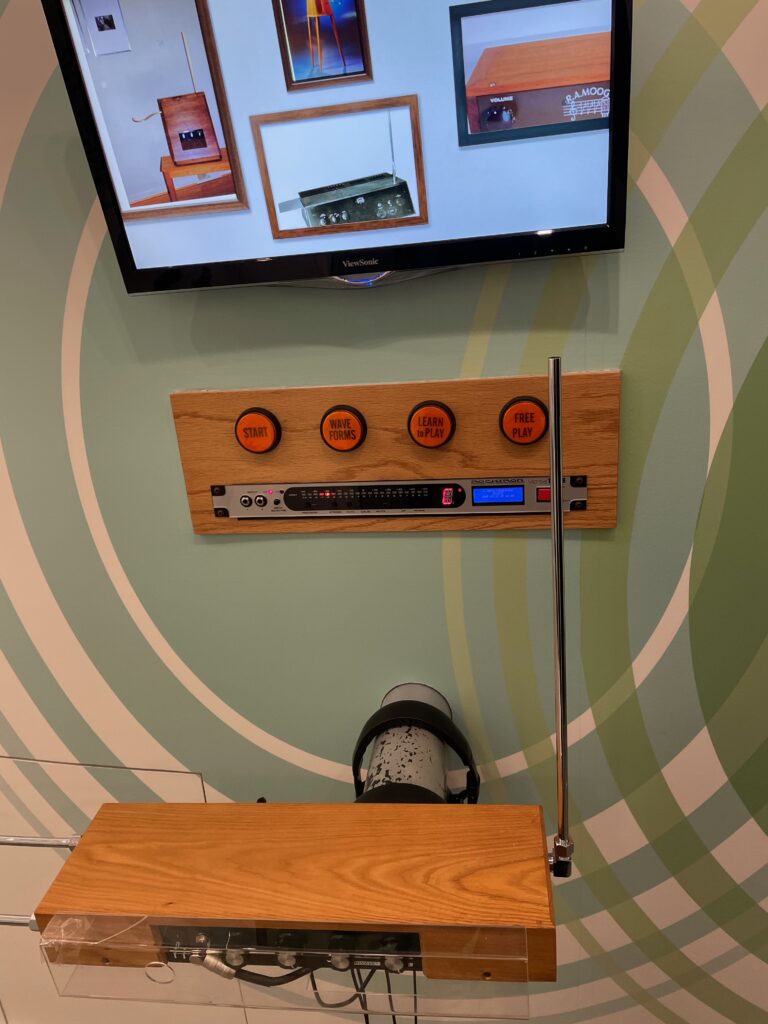Erik Visits an American Grave, Part 1,485
Inside this unfortunately locked cemetery lies the grave of Bob Moog.

Born in 1934 in New York, Moog grew up in Flushing and then went to Bronx Science. Moog’s father was an engineer and the family was also into music. His parents really wanted him to play the piano, and he could, but he didn’t find it very much fun. Rather, he preferred tooling around his father’s shop. As a child, he discovered the theremin. Now, if there’s one thing a kid would love to play with for all time, it is a theremin. Imagine, you move your hands around a couple of bars and weird sounds come out and you can totally change the sound? If this didn’t want to make parents shoot themselves from the noise, it would be the most popular toy of all time. In fact, if you can lock your kid in the basement to play, get them a theremin! Moog built his own when he was 14.
Moog went to City College and got a physics degree and then went to Columbia to study electrical engineering. Then it was off to Cornell for his PhD, which he got in 1965. Most engineers are the most boring people imaginable, but Moog was a definite exception to this rule. See, Moog wasn’t so interested in working on bridges or the like. No, he wanted to make weird noises and basically got the scientific credentials and training that would allow him to revolutionize the soundscape of the world.
This whole time he was in school, Moog was playing with his theremins and publishing articles about them. He started his own company to sell them too. Experimental musicians were immediately fascinated and they would buy them, play with them, improve upon them. The composer Raymond Scott bought one and connected it to a keyboard, creating the early electronic instrument called the Clavivox.
Moog himself started really transforming the world while he was Cornell, when he made his first synthesizer. These early synths were gigantic machines, almost like the old mainframe computers and they were totally unwieldy. But the potential to create weird new noises using electronics appealed to an awful lot of people, so like many technologies, they got a lot better really fast. Moog was a major player in this, reducing the number of vacuum tubes involved and instead incorporation another new technology, silicon transistors. Now, the specific details of synthesizers and noise technologies are a bit beyond my non-physics or engineering background. But let’s just say that the first Moog synthesizer in 1964 got a lot of attention because it was a lot more usable than previous models. Basically, Moog had just created the concept of the analog synthesizer. It was also a lot of cheaper. It was still about $10,000 but this was a lot more affordable than other models. Even more importantly, it was played with a keyboard instead of the punch cards used by the older RCA models. So for a musician, this not only was more accessible, but it also seemed like music.
Then in 1970 came the Minimoog, which is a huge gigantic advancement because it basically made Moog’s synthesizers available to any rock band and boy did they start using them. Not just of course rock though. Think of Stevie Wonder’s work in the 70s. Stevie and Moog worked closely together to get just what he wanted. The Minimoog only cost about $10,000 in 2023 dollars, so a successful band could definitely afford it, if not a starting band. Some of this was a necessary business decision, as the 60s versions of the Moog were falling out of fashion. In fact, it was Moog’s employees who really came up with it while he was on vacation and he wasn’t too thrilled about it when he got back. It was also the first Moog synthesize that allowed the player to bend notes like a guitarist. The Minimoog is all over the music of the next three decades and of course it is enormously influential even today. I mean, sure, it was used by those who loved excess. Will it shock you that the master of tastelessness, Rick Wakeman, was in love with it? No, of course it won’t. On the other hand, Stevie and Sun Ra took it into the Black musical tradition in two very different ways and helped transform the history of music, both popular and experimental. Then of course there was its gargantuan influence on the Krautrock bands, especially Kraftwerk. You probably can’t even have disco without the Minimoog. Then think of all the ways hip hop sampled all these sounds and found other uses for it too. We could go on here. It was an astounding innovation. And if its use in the 70s and 80s was inconsistent and often tasteless, well, blame the era, not Moog and his employees.
Now, Moog was a terrible businessman. He hardly ever made money off any of this stuff. He was the classic tinkerer for whom the invention was far more interesting than the potential profit on it. He didn’t really bother to patent much. The only thing he did patent was the transistor ladder filter, which is a technology completely beyond my understanding but has something to do with making the sounds. Had Moog bothered patenting his key synthesizer inventions, he would have been very rich. But he believed they should be in the public domain so others could play with them. And I mean, god bless him for that since his inventions utterly transformed music. So by the mid-70s, the business was falling apart. Other people were coming up with new stuff and they were actually good at the business part of it.
In 1971, Moog combined with some other companies and set up shop in Buffalo. The economic problems of the 70s decimated the company. He remained with the company until 1977 because his contract required it and he had stock options that needed to vest but he wanted to start out. So in 1978, he cashed out and set up shop in Asheville, North Carolina, where he would live for the rest of his life. He was no longer the same level of innovator–other people were advanced the synthesizer more directly now. But he had his instruments and Kurzweil Music Systems hired him to run a bunch of their electronic music stuff. He got rights to his own name again in 2002, so Moog Music was reborn. He continued to play with his instruments until his death, which was of brain cancer in 2005. He was 71 years old.
Now, I have to talk about the wonderful Moog Museum in Asheville. It’s not large, but it is awesome. You can play a theremin!!!! Of course you have to wear headphones so, in the words of the employee I talked to “to protect our sanity.” Ha ha. I got there real early and there was no one else in there so I spent like 15 minutes on the theremin, trying to figure out how to control the sound. I had no idea, but at least I could pretend I was Sun Ra or something and make weird noises! Here’s my picture of the theremin!

Then there are some awesome kiosks where you can listen to the different kind of Moogs and relive how the sound advanced year by year and where it appeared in popular culture, which was a great excuse to listen to the Beverly Hills Cop theme song again. There are also hilarious pictures like this:

Oh god, this is peak 70s, jesus……
And yes, I bought a Squarewave to Heaven t-shirt.
Bob Moog is buried in Lou Pollock Memorial Park, Asheville, North Carolina. The cemetery was locked when I was there, but below is a picture someone else took of the actual grave. At first I wondered if the cemetery was locked because of anti-Semitic graffiti or something. I mean, a Jewish cemetery in North Carolina…..But I don’t think so. I am pretty sure it is because of homelessness. Asheville is one of those tolerant eastern towns that has a homelessness issue like western cities. There were a lot of them around the cemetery. So I assume it is to protect the cemetery from people living there.

If you would like this series to visit other American music innovators, you can donate to cover the required expenses here. Les Paul is in Waukesha, Wisconsin and Orville Gibson is in Malone, New York. Previous posts in this series are archived here and here.


